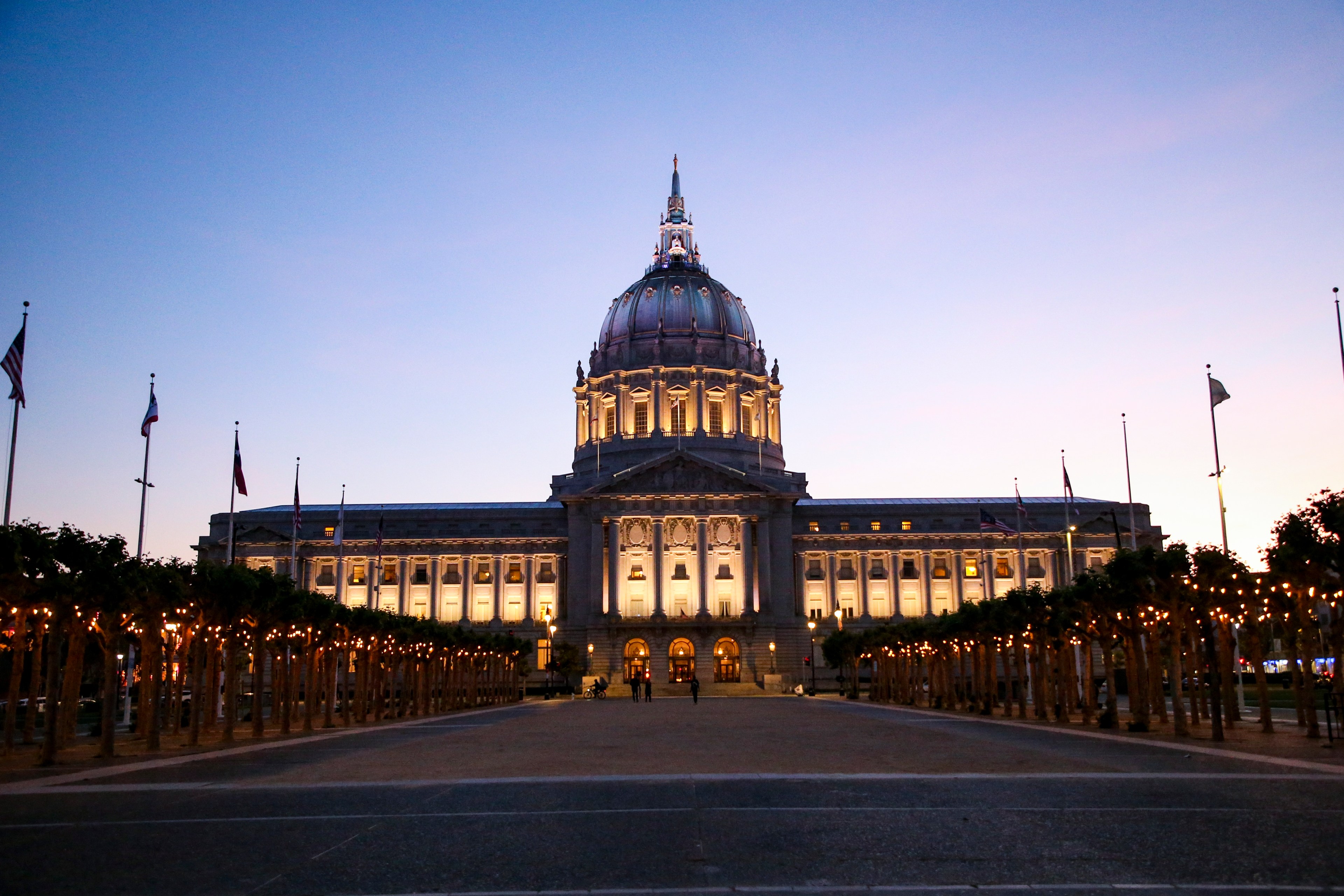City Guides tour guide Rob Spoor has been giving walking tours for 42 years—almost as long as the volunteer organization itself has existed. His original tour was the same one that got the nonprofit started: the history of City Hall.
But after years of giving the same tour and telling the same macabre stories like those of the assassinations of Harvey Milk and George Moscone—two politicians slain under the golden dome—something strange happened. People began coming to Spoor with ghost stories.
San Francisco’s civic seat sits next to what was the city’s first municipal graveyard, Yerba Buena Cemetery, and Spoor attributes the paranormal activity to the site’s historic location. Spoor decided that City Hall deserved a separate ghost tour, which he designed and led for some 15 years before it went on hiatus due to the pandemic.
It all began with a deputy sheriff, who pulled Spoor aside to tell him about his supernatural encounters. He rattled off what the volunteer tour guide called “an encyclopedia of paranormal activity,” including hearing voices and footsteps when no one was present, office chairs rattling and clanking around in empty rooms and bathroom faucets turning on and off on their own.
As Spoor developed his haunted tour of City Hall, more and more people came to him with stories, in particular maintenance and cleaning crew, who often work the graveyard shift (no pun intended).
They reported the metal detectors on Polk Street going off in the wee hours of the morning when no one was around to trigger them, people feeling their hair move as if someone had run their fingers through it and custodians trying to open bathroom doors that pushed back.
But perhaps the creepiest tale Spoor told involves a different, then-recently hired deputy sheriff who dismissed the haunting rumors as nonsense, just a lame way to scare the new guy around.
“About six months later, he was walking down a hallway checking doors to make sure they were locked,” Spoor said. “All of a sudden, he felt a rush of air against his cheek and then in his ear—and I mean directly into his ear—a voice said, Now you know.”
Spoor has had his own chilling encounters, too.
At one point, he was speaking with a City Hall employee about building up his ghost tour when he said a motion-activated light came on in the storage room next to them. There was no one inside the locked room, and it only had one door.
Another time, while he was giving his ghost tour, he recalls feeling someone poke him in the back. But when he turned around to apologize for getting in someone’s way, he said there was no one there.
Spoor became so entranced with the accumulating stories—and his own encounters—that at one point he brought along a psychic to assess the building as part of his research.
“We got to a certain spot on the second floor, and [the psychic] said, ‘This is really bad, we have to get out of here and it’s very powerful,’” Spoor recounted. The pair was standing next to the spot where the former mayor had been assassinated.
The psychic, a foreigner who had recently arrived in the country, could not have known about the Moscone and Milk assassinations, Spoor said. But it’s not only this dark chapter of San Francisco history that Spoor believes spurs the haunted happenings—it’s the much earlier legacy of the local cemetery.
Yerba Buena cemetery opened in 1850, was full by 1858 and remained in place until around 1868, said Beth Winegarner, author of San Francisco’s Forgotten Cemeteries: A Buried History. Bounded by Larkin, McAllister and Market, the Yerba Buena Cemetery is under what is today the Main Branch of the San Francisco Public Library.
“But just because it was not literally under the current City Hall doesn’t mean there aren’t angry ghosts,” Winegarner said.
In the 1860s and 1870s, as the population of San Francisco exploded due to the Gold Rush, a search began for a new site for the City Hall. With space at a premium, the old cemetery became a prime candidate as a large piece of land with an unpopular use (graveyards at that time were thought to be vectors of disease).
The buried bodies, around 7,000 in total, were supposed to be moved to other cemeteries.
“The truth is that most of the people buried at Yerba Buena are still there,” Winegarner said. It’s not the first time grave sites have not been properly moved out of San Francisco.
It took 25 years to complete the elaborate City Hall—which, at the time, was the largest municipal building west of Chicago—on top of San Francisco’s first municipal cemetery. Yet, it hadn’t been standing a decade before it was reduced to ruins by the 1906 Great Earthquake and Fire. Our present-day City Hall, which opened in 1915, was constructed adjacent to the previous one—and the cemetery—which is now the site of the Main Library.
During the library’s construction, numerous bone fragments as well as Chinese coins and jewelry were found in the ground. In the early 2000s, 97 bodies were unearthed during renovations of the Asian Art Museum, Winegarner said, and were reinterred at Cypress Lawn in Colma, a suburb south of the city that’s become known as San Francisco’s “city of the dead.”
“If you go there now, there’s no sign of it,” said Winegarner of the historic cemetery that held some of the first souls to build the city. “I would love to see some sort of marker that this could have been the first city cemetery.”
